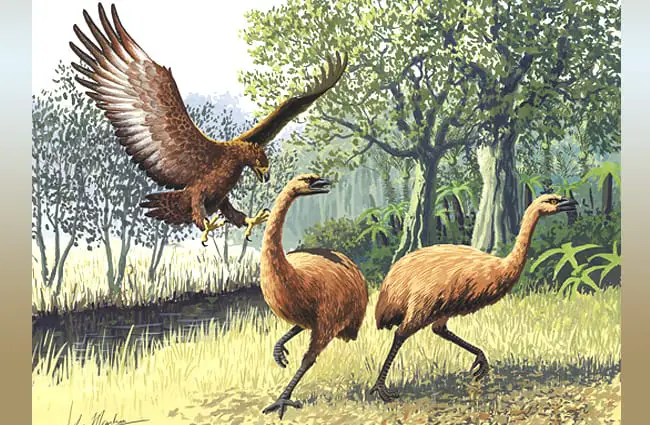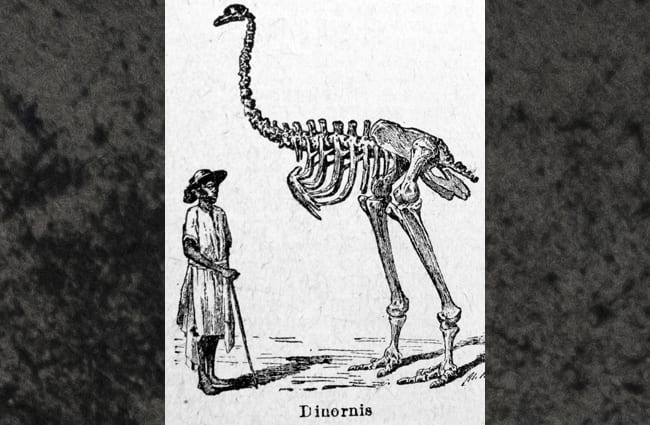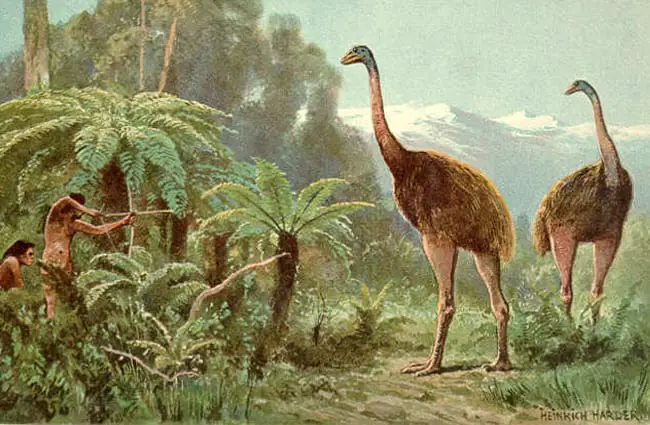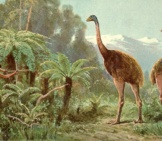The Moa was a large flightless birds that lived on the islands of New Zealand. These birds looked like a massive version of the emu. Unlike ostriches, emus, cassowaries, and other flightless birds, Moas didn’t have any wings at all. Researchers believe that they went extinct around the year 1400 B.C. Read on to learn about the Moa.
Description of the Moa
Nine different species of Moas roamed the islands on New Zealand. The largest of the species stood at 12 feet tall and weighed over 500 pounds. However, not all of the different species were quite so gargantuan, and some species were about the size of modern day ratites.
These birds looked similar to emus in body shape, with long necks and long legs. However, researchers believe that they walked with their necks stretched in front of them, rather than walking fully upright.
Interesting Facts About the Moa
Even though the last of these birds died thousands of years ago, researchers still know quite a few fun facts about them. Learn more about these monstrous birds below.
- Curious Cousins – Several different birds living today seem like they might be closely related to these extinct birds. Emus look very similar, and kiwis are similar in shape and lived in the same region. Amazingly, when scientists compared their genetic material, they found that Moas are actually more closely related to the tinamous of South America.
- Truly Wingless – All living flightless birds, including emus, ostriches, rheas, cassowaries, and kiwis, have some form of wings. Most have vestigial wings, or small remnants that no longer function in any way. Before their extinction, Moas had no wings at all. They didn’t even have a single wing bone.
- Slow Going – Some species of these birds were incredibly large, but it took a long time for them to get that size. Depending on the species, these birds didn’t reach full size for over three years, and some species took as long as nine years to fully mature!
- Slow Growth = Fast Demise – Sadly, when it takes a long time to reach sexual maturity, it also takes a long time for new generations to reproduce. With hunting pressure, Moas simply couldn’t maintain their populations. Researchers believe hunting drove them to extinction.
Habitat of the Moa
The different Moa species inhabited different ecosystems and habitats. Some species lived in beech forests, others in shrublands, subalpine areas, coastal regions, and more. They lived at both sea level, and up into relatively mountainous regions. Different species lived in areas with high rainfall, or low rainfall, depending on the region in New Zealand.
Distribution of the Moa
All of the nine species of this bird lived on the islands of New Zealand. The bush, eastern, heavy-footed, crested, and upland Moa all lived on the South Island.
The Mantell’s Moa lived on North Island, and the coastal Moa inhabited both North Island and South Island. Each species had its own unique distribution, though some populations overlapped with those of other populations.
Diet of the Moa
These birds died off well before researchers could study their behavior. However, we can gain some information about their diets from their fossilized remains. Researchers have studied the contents of their gizzards, and their fossilized feces, also known as coprolite.
Using this information, scientists believe that these birds were herbivorous, and fed primarily on plant matter. They ate mostly leaves and twigs, and their sharp beaks worked like a pair of shears to snip off choice leaves and branches.
Moa and Human Interaction
Human hunting directly drove these birds to extinction. The Maori people, or the native people of New Zealand, migrated to the islands around the year 1300. They hunted the various Moa species extensively, and destroyed their habitats to create villages.
It took less than 150 years for humans to drive them to extinction. By killing off these birds, the native people also killed off the Haast’s eagle, which fed almost exclusively on them.
Domestication
Humans never domesticated Moas in any way.
Does the Moa Make a Good Pet
No, it would be quite impossible to keep a Moa as a pet, as they are extinct. However, you could purchase a Moa fossil if you have the means!
Moa Care
These birds never lived in any type of zoo, and it is impossible to know what type of care they might have required. However, we can assume their needs were like those of other, similar flightless birds.
Zoos would have needed massive enclosures, particularly for the largest species. They would have had to replicate their herbivorous diet as closely as possible. Obviously, the exact specification of their care would vary from species to species.
Behavior of the Moa
No scientist ever studied a living Moa, because they went extinct well before any Europeans arrived on New Zealand. However, based on their anatomy we can infer that they were terrestrial birds, which lived on the ground.
They likely spent most of their time roaming in search of food. If they were social birds, they were not social nesters, and no researcher has found their nests in close proximity to one another.
Reproduction of the Moa
We know very little about the breeding strategies of these birds. Again, no researcher ever studied this bird in person and no record of their behavior exists. Scientists have studied remains and concluded that Moas probably only laid a single egg per season, like kiwis.
Their incubation was likely extensive, possibly around two months. It took a very long time for the chicks to reach sexual maturity, and most Moas were somewhere between the ages of 5 and 10 years before they reproduced.







![Red Angus Closeup of a beautiful Red Angus cowPhoto by: U.S. Department of Agriculture [pubic domain]https://creativecommons.org/licenses/by/2.0/](https://animals.net/wp-content/uploads/2020/03/Red-Angus-4-238x178.jpg)


![Red Angus Closeup of a beautiful Red Angus cowPhoto by: U.S. Department of Agriculture [pubic domain]https://creativecommons.org/licenses/by/2.0/](https://animals.net/wp-content/uploads/2020/03/Red-Angus-4-100x75.jpg)

